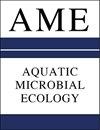元条形码技术揭示的东赤道印度洋微真核生物多样性
IF 1.1
4区 环境科学与生态学
Q3 ECOLOGY
引用次数: 1
摘要
利用18S rRNA基因元条形码技术,研究了赤道东印度洋(EEIO) 4个站点的表层和深层叶绿素最大值(DCM)的微真核生物多样性和分布。结果表明:微真核生物群落以鞭毛藻门、放射藻门、绿藻门、绿藻门和纤毛藻门5门为主;根据水体来源和深度,将微真核生物群落划分为3个类群:(1)类群位于孟加拉湾表层,盐度较低,以放射菌A群、螺旋体和海洋层菌为主;(2)第II组为阿拉伯海高盐度水体入侵范围内的DCM,其中绿藻科和远洋藻科较为丰富;(3) III组位于0°~ 5°S的地表水中,以Dinophyceae富集。另外,在4°S时,Caecitellaceae paraparvulus丰富,垂直混合较弱。这项研究提供了EEIO中微真核生物多样性的第一个基线。本文章由计算机程序翻译,如有差异,请以英文原文为准。
Diversity of picoeukaryotes in the eastern equatorial Indian Ocean revealed by metabarcoding
We used 18S rRNA gene metabarcoding to investigate picoeukaryotic diversity and distribution at the surface and deep chlorophyll maximum (DCM) of 4 stations in the eastern equatorial Indian Ocean (EEIO). The results showed that picoeukaryotic communities were dominated by 5 phyla: Dinoflagellata, Radiolaria, Chlorophyta, Ochrophyta and Ciliophora. The picoeukaryotic communities were classified into 3 groups matching their water mass origins and depth: (1) Group I was in the surface waters of the Bay of Bengal, which had low salinity, and was dominated by Radiolaria Group A, Spirotrichea and marine stramenopiles; (2) Group II was in the DCM within the intrusion of Arabian Sea high salinity water, in which Chloropicophyceae and Pelagophyceae were more abundant; and (3) Group III was located in the 0°-5°S surface water, which was enriched by Dinophyceae. In addition, Caecitellaceae paraparvulus was abundant at 4°S, where weak vertical mixing occurred. This study provides the first baseline of picoeukaryotic diversity in the EEIO.
求助全文
通过发布文献求助,成功后即可免费获取论文全文。
去求助
来源期刊

Aquatic Microbial Ecology
环境科学-海洋与淡水生物学
CiteScore
3.30
自引率
0.00%
发文量
8
审稿时长
3.0 months
期刊介绍:
AME is international and interdisciplinary. It presents rigorously refereed and carefully selected Research Articles, Reviews and Notes, as well as Comments/Reply Comments (for details see AME 27:209), Opinion Pieces (previously called ''As I See It'') and AME Specials. For details consult the Guidelines for Authors. Papers may be concerned with:
Tolerances and responses of microorganisms to variations in abiotic and biotic components of their environment; microbial life under extreme environmental conditions (climate, temperature, pressure, osmolarity, redox, etc.).
Role of aquatic microorganisms in the production, transformation and decomposition of organic matter; flow patterns of energy and matter as these pass through microorganisms; population dynamics; trophic interrelationships; modelling, both theoretical and via computer simulation, of individual microorganisms and microbial populations; biodiversity.
Absorption and transformation of inorganic material; synthesis and transformation of organic material (autotrophic and heterotrophic); non-genetic and genetic adaptation; behaviour; molecular microbial ecology; symbioses.
 求助内容:
求助内容: 应助结果提醒方式:
应助结果提醒方式:


